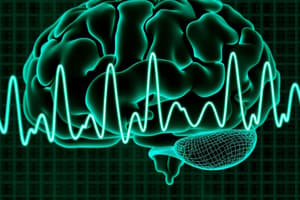Podcast
Questions and Answers
What is the primary challenge associated with the electrical contribution of a single cortical neuron?
What is the primary challenge associated with the electrical contribution of a single cortical neuron?
- High resistance in neural tissue
- Insufficient energy production
- Limited spatial coverage
- Weak signal strength (correct)
What aspect of neural function does EEG primarily measure?
What aspect of neural function does EEG primarily measure?
- Individual neuron activity
- Chemical signaling between neurons
- Electrical signals from all neurons (correct)
- Physical structure of the neuron
What obstacles must a neural signal overcome to reach the electrodes?
What obstacles must a neural signal overcome to reach the electrodes?
- Several layers of non-neural tissue (correct)
- Only the skin
- Only the blood-brain barrier
- Only the skull bones
Which of the following best describes the primary limitation of EEG?
Which of the following best describes the primary limitation of EEG?
Which of the following is NOT a layer that electrical signals from cortical neurons must pass through to reach electrodes?
Which of the following is NOT a layer that electrical signals from cortical neurons must pass through to reach electrodes?
What effect does the presence of non-neural tissue have on the electrical signals from cortical neurons?
What effect does the presence of non-neural tissue have on the electrical signals from cortical neurons?
How does dendritic function relate to the signals measured by EEG?
How does dendritic function relate to the signals measured by EEG?
In which scenario would EEG not be preferable for monitoring neural activity?
In which scenario would EEG not be preferable for monitoring neural activity?
Why might the electrical signals from cortical neurons be considered insufficient for direct measurement at electrodes?
Why might the electrical signals from cortical neurons be considered insufficient for direct measurement at electrodes?
Which of the following statements is true regarding the information provided by EEG?
Which of the following statements is true regarding the information provided by EEG?
What type of neuron are pyramidal neurons classified as?
What type of neuron are pyramidal neurons classified as?
In which part of the nervous system are pyramidal neurons predominantly found?
In which part of the nervous system are pyramidal neurons predominantly found?
Why do neuroscientists often focus on populations of neurons rather than single neurons?
Why do neuroscientists often focus on populations of neurons rather than single neurons?
What is a key characteristic of multipolar neurons like pyramidal neurons?
What is a key characteristic of multipolar neurons like pyramidal neurons?
What is the primary function of dendrites in multipolar neurons such as pyramidal neurons?
What is the primary function of dendrites in multipolar neurons such as pyramidal neurons?
Flashcards
Pyramidal neuron
Pyramidal neuron
A type of neuron with multiple extensions (axons and dendrites).
Multipolar neuron
Multipolar neuron
A nerve cell with multiple extensions.
Brain areas
Brain areas
Specific locations in the brain.
Population of neurons
Population of neurons
Signup and view all the flashcards
EEG signal
EEG signal
Signup and view all the flashcards
Neuron Contribution
Neuron Contribution
Signup and view all the flashcards
Signal Path
Signal Path
Signup and view all the flashcards
Electrodes
Electrodes
Signup and view all the flashcards
Non-Neural Tissue
Non-Neural Tissue
Signup and view all the flashcards
Signal Attenuation
Signal Attenuation
Signup and view all the flashcards
EEG
EEG
Signup and view all the flashcards
Neurons
Neurons
Signup and view all the flashcards
Study Notes
Electricity in the Nervous System
- The nervous system (NS) is a complex network of nerves, brain, and spinal cord.
- The NS transmits signals between the brain and the body's internal organs, controlling actions and reactions, and adjusting to the environment.
- The NS has two main parts:
- Central NS (made up of brain and spinal cord).
- Peripheral NS (made up of nerves branching from spinal cord to body parts).
- Autonomic NS (controls involuntary actions)
- Somatic NS (controls voluntary actions)
Neuron
- The basic unit of the nervous system is a neuron (nerve cell).
- Neurons are electrically excitable cells capable of generating, conducting, and transmitting electrochemical signals.
Nerve Cell Structure
- Key features of a neuron: cell body (soma), dendrites, axon, and terminal buttons.
- Soma: the cell body contains the nucleus.
- Dendrites: receive messages from other cells.
- Axon: transmits messages away from the cell body to other cells, muscles, or glands.
- Electrical signal (action potential) travels down the axon.
- Myelinated sheaths improve the speed of neural signals.
Neurons Classification
- Sensory neurons: found near receptors (sense organs), carry impulses from receptors to the CNS.
- Motor neurons: found near effectors (muscles and glands), carry impulses from the CNS to effectors.
- Interneurons: connect sensory and motor neurons; found entirely within the CNS.
Simple Reflex Circuit
- Information travels from skin receptors to the spinal cord via sensory neurons.
- Interneurons in the spinal cord connect to motor neurons and cause a response.
- The response is a reflex action (e.g., withdrawal from a stimulus).
Nerve Cell Membrane
- The cell membrane separates intracellular and extracellular environments in the body.
- Extracellular fluid is similar to seawater (mostly sodium and chloride ions).
- Intracellular fluid (cytosol) has potassium ions, and large negatively charged organic molecules.
Nerve Cell Membrane Electrical Properties
- The neuron membrane is an electrical insulator, but some ions can leak through.
- The membrane is permeable to potassium, slightly permeable to sodium, and impermeable to large organic ions. These properties create a potential difference across the membrane.
- This potential difference is maintained by ion pumps, which continuously move potassium ions into the cell and sodium ions out, keeping the inside of the neuron more negative than the outside.
Ion Pumps
- Ion pumps are enzymes that move ions against their concentration gradient, using energy from ATP breakdown.
- The sodium-potassium pump is key for maintaining the resting potential, pumping 3 sodium ions out for every 2 potassium ions pumped in.
Action Potential
- The neuron's exciting state (action potential) involves changes in membrane potential from the resting potential (approximately -70mV).
- A stimulus causes depolarization, allowing sodium ions to enter the cell.
- The rapid influx of positive charges changes the inside of the cell from negative to positive.
- When the threshold level is reached, a nerve impulse is triggered and propagates down the axon.
- Voltage-gated channels are responsible for opening and closing during action potential.
Signal Transmission in Neurons
- Neurons communicate through synapses (junctions).
- Chemical synapses use neurotransmitters to send signals between neurons.
- Electrical synapses use ion flow to transmit signals.
Detecting Neuron Activity
- EEG (electroencephalography) measures electrical activity.
- MEG (magnetoencephalography) measures magnetic fields.
Brain Waves
- EEG measures brain waves (frequency and amplitude) related to various mental states (e.g., awake, sleep, etc.)
- Delta waves (low frequency, deep sleep)
- Theta waves (lower-mid frequency, drowsy)
- Alpha waves (lower-mid frequency, relaxed concentration)
- Beta waves (higher frequency, wakefulness, focus)
Studying That Suits You
Use AI to generate personalized quizzes and flashcards to suit your learning preferences.




